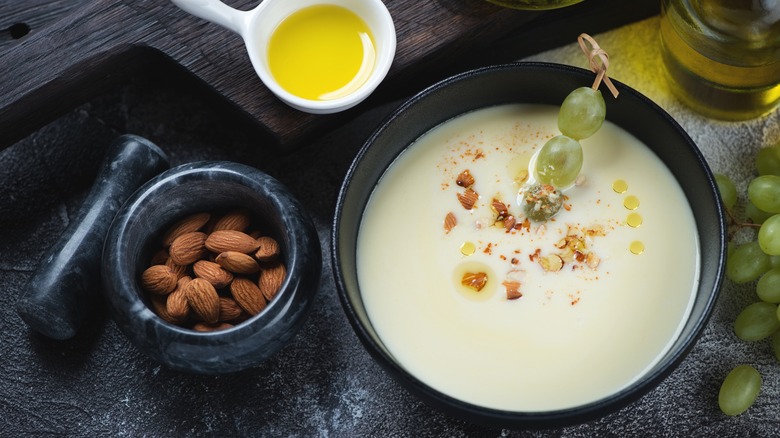The Cold, Creamy Soup That Dates Back To The Middle Ages
Cold soups can be a bit of a polarizing topic, even when they have a heritage going back thousands of years. In the U.S. at least, soups are thought of as comfort food, warm, hearty, and inviting, and something that is best eaten while there is a chill on the window. Of course, many types of soups are enjoyed year-round. But fundamentally when we think of soup many of us think "hot," and the ones that are made to eat cold may have often an unfair air of skepticism around them. To the unfamiliar, perhaps soups like borscht seem like ways to turn soup into a salad, a big comforting bowl of beef stew swapped out for health food. That would ignore, of course, that plenty of salads are completely delicious.
Luckily, not everyone has a suspicion of cold soups. Mediterranean and Middle-Eastern nations in particular have an affinity for these chilled dishes, with Food & Wine listing Spanish gazpacho and Persian chilled yogurt soup as two favorites that are classics of their respective cuisines. Gazpacho is in fact one of the few cold soups to have transcended its origins and become popular worldwide, but there is an even older cold soup from Spain, and it may even be the forerunner of its famous cold, tomato-based cousin.
Ajo Blanco: the cold Spanish soup made with almonds
Ajo blanco is a striking white soup from Andalusia, a region of southern Spain where the dish is celebrated during a September festival (via the LA Times). It's made with stale bread, vinegar, and water, with almonds and garlic as the biggest flavors. Unlike red gazpachos, which would not have been made until after tomatoes were brought back to Europe from the Americas in the 16th century, ajo blanco traces its roots back to the Moorish occupation of the Iberian peninsula in the Middle Ages between the early 8th and late 15th centuries. The Guardian suggests the almonds that help thicken the soup could have been introduced to Spain by the Moors, to begin with.
As for how ajo blanco actually tastes, it is described as having a very subtle flavor. The pureed almonds release their milk to form the underlying base, so think unsweetened almond milk meets a little garlic. The almonds also work with the pureed bread to make ajo blanco extremely creamy despite having no dairy. It often relies on garnishes like apples or grapes to brighten the dish and round out the experience. Ajo blanco can also make a great base for other food like scallops. According to the LA Times, people in Granada pair it with roasted potatoes while some versions may incorporate marinated anchovies. Pull out your blender, give it a try, and you just might make this soup a staple of your summer menu.

